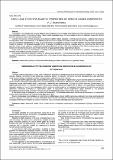Поиск по всему репозиторию:
Early-age effective elastic properties of cement-based composites

Открыть/скачать файлы документа
Дата издания
2024Издательство
БрГТУУДК
691.542Библиографическое описание
Kravchenko, V. V. Early-age effective elastic properties of cement-based composites = Эффективные упругие свойства цементных композитов в раннем возрасте / V. V. Kravchenko. – Text : direct // Vestnik of Brest State Technical University. – 2024. – № 3. – P. 31–37. – Bibliography: 21 titles.Аннотация
The problem of the prediction the early age effective elastic properties of cement-based composites is one of the most important and at the same time complicated problems of concrete technology. Cement-based composites consist of a large number of randomly distributed phases with different geometric shapes and sizes at each structural level.Currently, there are two common approaches to modeling the effective elastic properties of cement-based composites –analytical andnumerical homogenization. Most of the researches of the effective properties of cement-based composites focused their attention on the effective medium theory as a part of analytical homogenization, in which all composite phases are considered as spherical inclusions leading to relatively simple computational models for prediction. This significant assumption affects the accuracy of predicting the effective properties, since it is awell-known fact that the real geometric shape of most phases of cement-based composites differs from spherical. One of the drawbacks of the effective medium theory is that solutions for non-spherical inclusions can only be received for a regular geometric shape representing an ellipsoid.At the same time, one of the advantages of numerical homogenization based on finite element analysis is the possibility of calculating elastic properties for an arbitrary geometric shape of inclusions.The purpose of the study is multiscale modelling the effective elastic properties of cement-based composites, using a combination of analytical and numerical homogenization, considering the geometric shape of the phases at each heterogeneous level, close to their real shape in the structure of composites.
Аннотация на другом языке
Проблема оценки эффективных упругих свойств цементных композитов в раннем возрасте является одной из важнейших и в то же время сложных проблем технологии бетона. Цементные композиты состоят из большого количества случайно распределенных фаз различной геометрической формы и размеров на каждом из элементарных уровней строения их структуры. В настоящее время существуют два распространенных подхода к моделированию эффективных упругих свойств цементных композитов –аналитическая и численная гомогенизация. Большинство проведенных исследований эффективных свойств цементных композитов основаны на положениях теории эффективной среды, относящейся к аналитической гомогенизации, в которых все фазы композита рассматривают как сферические включения, что позволяет получить относительно простые расчетные модели для их оценки. Это существенное допущение оказывает влияние на точность прогнозирования свойств, поскольку хорошо известно, что реальная геометрическая форма большинства фаз цементных композитов отличается от сферической. Одним из недостатков теории эффективной среды является то, что решения для несферических включений, могут быть получены только для правильной геометрической формы в виде эллипсоида.В тоже время одним из преимуществ численной гомогенизации на основе конечно-элементного анализа является возможность определения упругих свойств для произвольной геометрической формы включений.Данное исследование ориентировано на моделирование эффективных упругих свойств цементных композитов на основе многоуровневой схемы их структуры, используя для их оценки комбинацию аналитической и численной гомогенизации, рассматривая геометрическую форму фаз на каждом элементарном гетерогенном уровне, близкую к их реальной форме в структуре цементных композитов.
URI документа
https://rep.bstu.by/handle/data/47787Документ расположен в коллекции
- № 3 (135) 2024 [28]

Это произведение доступно по лицензии Creative Commons «Attribution-NonCommercial» («Атрибуция-Некоммерчески») 4.0 Всемирная.